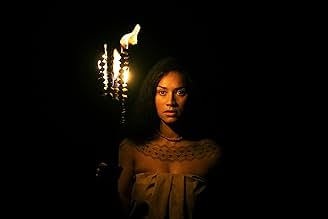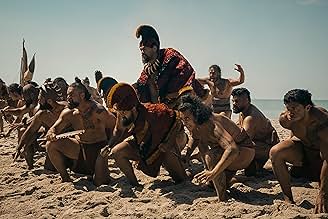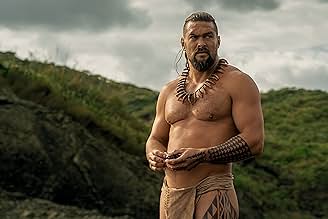हवाई द्वीपों के एकीकरण की एक रोमांचक और अभूतपूर्व कहानी, एक स्थानीय दृष्टिकोण से. एक हवाईयन युद्ध प्रमुख, युद्धरत द्वीपों को उपनिवेशीकरण के खतरे से बचाने के लिए उन्हें एकजुट करने के एक खूनी ... सभी पढ़ेंहवाई द्वीपों के एकीकरण की एक रोमांचक और अभूतपूर्व कहानी, एक स्थानीय दृष्टिकोण से. एक हवाईयन युद्ध प्रमुख, युद्धरत द्वीपों को उपनिवेशीकरण के खतरे से बचाने के लिए उन्हें एकजुट करने के एक खूनी अभियान में शामिल होता है.हवाई द्वीपों के एकीकरण की एक रोमांचक और अभूतपूर्व कहानी, एक स्थानीय दृष्टिकोण से. एक हवाईयन युद्ध प्रमुख, युद्धरत द्वीपों को उपनिवेशीकरण के खतरे से बचाने के लिए उन्हें एकजुट करने के एक खूनी अभियान में शामिल होता है.
एपिसोड ब्राउज़ करें
फ़ीचर्ड समीक्षाएं
I have been waiting forever for a good series about the early Hawaiian kingdom being united. I only watched the first one, and I'm sold so far. I hope they keep close to the historical events (even with Hollywood artistic interpretation or embellishments). The first inaccuracy is that the women did not cover up their upper bodies until the missionaries came and made them cover up...but you can't have all the women topless in this series...ha. Many scenes with actors are not filmed in Hawaii, but I guess it's hard to get known Mauna and the backgrounds of scenes without CGI or getting rid of all the current buildings and architecture. You can also tell that many extras and background people are New Zealanders and such. I wished they had used more extras with real Hawaiian bloodlines (the scene where they embarked on O'ahu's beach for battle was obvious). I don't know why they couldn't use more Hawaiian "locals" for parts. It was funny to see "Aquaman" and his dad, Tom Curry, share leadership scenes together in this series....
I was born on Maui, went to high school on Kauai, but unfortunately missed my junior year of Hawaiian history. Hopefully this will be on spot and a good for all to understand da early days of the islands...before England, U. S. and settlers took over, of course. Strap in...I feel this is going to be a good series.
Cinemography/editing is decent but typical without creative angles. Music is decent, but it would be awesome if they used more light chants in the background to intensify action or dramatic scenes (Kahiko, Auana, Hapa Haole, etc.). Acting is decent for the main characters. Overall, I am excited to see what this brings. Will it be as good as what "Shogun" did in telling Japan's samurai ancient history? Let's see how they do...
I was born on Maui, went to high school on Kauai, but unfortunately missed my junior year of Hawaiian history. Hopefully this will be on spot and a good for all to understand da early days of the islands...before England, U. S. and settlers took over, of course. Strap in...I feel this is going to be a good series.
Cinemography/editing is decent but typical without creative angles. Music is decent, but it would be awesome if they used more light chants in the background to intensify action or dramatic scenes (Kahiko, Auana, Hapa Haole, etc.). Acting is decent for the main characters. Overall, I am excited to see what this brings. Will it be as good as what "Shogun" did in telling Japan's samurai ancient history? Let's see how they do...
Reminds me of the authentic look and feel of the film Apocalypto. Momoa and Morrison are strong anchors with a undeniable on camera presence. Nothing looks or feel fake or weak. Every department that created the series did an amazing job. The language is fascinating and delivered so well by the actors. It's an entertaining thrill and a dynamic history course all in one.
Wow seriously ignore the dumb negative reviews clearly most of those are folks who did not even watch any of the episodes so far. Check out this new epic story - I'm hooked!
Chief of War is more than just a historical drama-it's a cinematic homage to a culture rarely given this much screen time, and it doesn't waste a single frame in telling its story with reverence, grit, and heart.
Scenery and Cinematography: A Visual Masterpiece
From the opening shots, the Hawaiian islands (and yes I know where it was filmed so what it's beautiful and works setting the right tone) are treated not merely as a backdrop but as a living character. The lush greens, volcanic reds, and expansive blues of the Pacific are captured in breathtaking wide-angle shots and sweeping aerial views. The cinematography is meticulous, almost meditative at times, with deliberate pacing that draws you into the natural rhythm of island life-and the turbulent undercurrents of war.
Whether it's mist-covered cliffs, churning surf, or smoke rising from tribal fires, every scene feels handcrafted. Natural light is used to stunning effect, particularly in golden-hour battles and quiet conversations under torchlight. It's immersive and evocative-clearly influenced by Terrence Malick and The Last of the Mohicans-but with a distinctly Polynesian heartbeat.
Music and Sound Design: A Spiritual Undercurrent - Zimmer sets the mood
The score blends traditional Polynesian instruments with modern cinematic cues to elevate tension and emotion without overpowering the moment. The use of indigenous chants, percussion, and melodic motifs grounds the story in authenticity and identity. Music here doesn't just accompany the narrative-it anchors it. In quieter scenes, the ambient sound of the ocean or jungle builds a visceral sense of place that never lets you forget where you are: this is Hawaii, before the West came calling.
Characterization: Layered, Human, and Authentic
Jason Momoa leads with raw intensity, but it's his restraint in key moments that makes his performance resonate. He embodies a man torn between tradition and transformation-between chief and warrior, between vengeance and vision. The supporting cast is equally strong, particularly the women, who are not sidelined but integral to the emotional and political stakes of the story.
The show avoids turning characters into mere archetypes. Even the antagonists are layered, with motivations rooted in power, fear, or survival, rather than cartoonish villainy. Tribal alliances, family dynamics, and individual ambition collide with believable complexity.
Storytelling: Epic in Scope, Intimate in Heart
At its core, Chief of War tells a story about identity-cultural, personal, and generational. It balances sweeping historical events with intimate personal struggles. The pacing leans slow-burn in the best way, giving characters and conflicts time to breathe.
The writing doesn't spoon-feed exposition, trusting the audience to stay engaged and follow along as customs, rituals, and politics unfold naturally. This lends the show a sense of realism and weight, making the betrayals more heartbreaking and the triumphs more earned.
Themes of legacy, honor, resistance, and sacrifice are woven throughout without becoming didactic. And while the show doesn't shy away from brutality, it also leaves room for beauty, love, and quiet reflection.
Final Verdict:
Chief of War is a powerful, respectful, and beautifully crafted series that elevates indigenous storytelling to a new cinematic high. It's a rare show that educates while it entertains, moves you while it mesmerizes. With its gripping narrative, stunning visuals, rich characters, and soulful score, it's a must-watch for fans of historical epics and cultural storytelling done right.
Chief of War is more than just a historical drama-it's a cinematic homage to a culture rarely given this much screen time, and it doesn't waste a single frame in telling its story with reverence, grit, and heart.
Scenery and Cinematography: A Visual Masterpiece
From the opening shots, the Hawaiian islands (and yes I know where it was filmed so what it's beautiful and works setting the right tone) are treated not merely as a backdrop but as a living character. The lush greens, volcanic reds, and expansive blues of the Pacific are captured in breathtaking wide-angle shots and sweeping aerial views. The cinematography is meticulous, almost meditative at times, with deliberate pacing that draws you into the natural rhythm of island life-and the turbulent undercurrents of war.
Whether it's mist-covered cliffs, churning surf, or smoke rising from tribal fires, every scene feels handcrafted. Natural light is used to stunning effect, particularly in golden-hour battles and quiet conversations under torchlight. It's immersive and evocative-clearly influenced by Terrence Malick and The Last of the Mohicans-but with a distinctly Polynesian heartbeat.
Music and Sound Design: A Spiritual Undercurrent - Zimmer sets the mood
The score blends traditional Polynesian instruments with modern cinematic cues to elevate tension and emotion without overpowering the moment. The use of indigenous chants, percussion, and melodic motifs grounds the story in authenticity and identity. Music here doesn't just accompany the narrative-it anchors it. In quieter scenes, the ambient sound of the ocean or jungle builds a visceral sense of place that never lets you forget where you are: this is Hawaii, before the West came calling.
Characterization: Layered, Human, and Authentic
Jason Momoa leads with raw intensity, but it's his restraint in key moments that makes his performance resonate. He embodies a man torn between tradition and transformation-between chief and warrior, between vengeance and vision. The supporting cast is equally strong, particularly the women, who are not sidelined but integral to the emotional and political stakes of the story.
The show avoids turning characters into mere archetypes. Even the antagonists are layered, with motivations rooted in power, fear, or survival, rather than cartoonish villainy. Tribal alliances, family dynamics, and individual ambition collide with believable complexity.
Storytelling: Epic in Scope, Intimate in Heart
At its core, Chief of War tells a story about identity-cultural, personal, and generational. It balances sweeping historical events with intimate personal struggles. The pacing leans slow-burn in the best way, giving characters and conflicts time to breathe.
The writing doesn't spoon-feed exposition, trusting the audience to stay engaged and follow along as customs, rituals, and politics unfold naturally. This lends the show a sense of realism and weight, making the betrayals more heartbreaking and the triumphs more earned.
Themes of legacy, honor, resistance, and sacrifice are woven throughout without becoming didactic. And while the show doesn't shy away from brutality, it also leaves room for beauty, love, and quiet reflection.
Final Verdict:
Chief of War is a powerful, respectful, and beautifully crafted series that elevates indigenous storytelling to a new cinematic high. It's a rare show that educates while it entertains, moves you while it mesmerizes. With its gripping narrative, stunning visuals, rich characters, and soulful score, it's a must-watch for fans of historical epics and cultural storytelling done right.
This series is what we Hawaiians have needed forever. Finally someone ( This is Jason Momoas project ) is telling our story accurately. Love that the Olelo Hawaii is the language spoken. Love that there are Polynesian Actors who can authentically speak the beautiful Hawaiian language . It is a fictional story based on real events. I cant wait to see the rest.
To those complaining about the language and subs - you do realise that not everyone in this world speaks English..? That there are many different languages? Have you not ever watched foreign movie? JC. My mother is 75 and watches everything in original with subtitles. If you can't manage then it's not the series problem. This is beautifully narrated and filmed story so far. Kudos to all actors.
क्या आपको पता है
- ट्रिवियाAs stated by Dwayne Johnson in the audio commentary for The Rundown (2003) he's been wanting to do this project for a very long time but Jason Momoa beat him to it
- कनेक्शनReferenced in The Nite-Cap: Has The Superhero Hype Come To An End? (2025)
टॉप पसंद
रेटिंग देने के लिए साइन-इन करें और वैयक्तिकृत सुझावों के लिए वॉचलिस्ट करें
August 2025 TV and Streaming Premiere Dates
August 2025 TV and Streaming Premiere Dates
Night Always Comes and "Outlander: Blood of My Blood" are two of this month's most anticipated TV releases. Check out our August calendar for more!
- How many episodes does Chief of War have?Alexa द्वारा संचालित
विवरण
- चलने की अवधि
- 50 मि
- रंग
- ध्वनि मिश्रण
- पक्ष अनुपात
- 2.39:1
इस पेज में योगदान दें
किसी बदलाव का सुझाव दें या अनुपलब्ध कॉन्टेंट जोड़ें








































